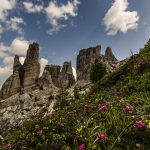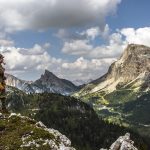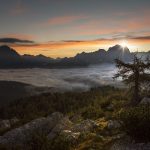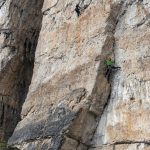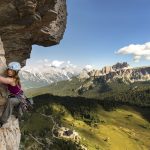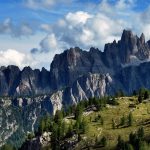Cutting a striking profile above the Cortina basin overlooking the Passo Falzarego, the famous five towers of Cinque Torri are one of the most strikingly beautiful and instantly recognisable rock formations in the Dolomites. Scattered between the main spires lies a wonderful labyrinth of scree, boulders, tunnels and trenches dating back to the Great War. Such was the strategic significance of the area that today the site plays host to a superb open air museum with carefully preserved soldiers’ quarters, artillery positions and lookout posts.
How To Get Here
The towers are situated above the Passo Falzarego and are usually approached using the Cinque Torri chairlift which departs from Rifugio Bai de Dones on the east side of the pass. From Cortina take the SS48 west for 15km, following signs for the Passo Falzarego to reach the large and well signposted chairlift car park.
Either take the chairlift up to Rifugio Scoiattoli which overlooks Cinque Torri or ascend on foot following the ski pistes beneath the lift to reach the towers in one hour.
Alternatively, before reaching the chairlift car park there is an access track which can be used to access the towers. Turn off at a 112km milestone following signs for Rifugio Cinque Torri and drive up the track for 3km to reach the rifugio. This access track is a steep single-lane road with infrequent passing places and limited parking at the top, so an early start is essential. Please note that this track is closed between 9:30 and 15:30 in August (and at other busy periods during the season).
Parking Lat/Long: 46.51897, 12.03792
What to shoot and viewpoints
The following viewpoints are described making a clockwise circuit of the five towers, starting and finishing at Rifugio Scoiattoli at the top of the Rifugio Bai de Dones chairlift.
Viewpoint 1 – Towers from Rifugio Scoiattoli
- The five towers as viewed from the west. Nikon D610, 14-24 at 18mm, ISO 100, 1/200s at f/9, July ©James Rushforth
- The classic shot of Cinque Torri.Nikon D610, 16-35 at 16mm, ISO 100, 1/200s at f/10, July. ©James Rushforth
Rifugio Scoiattoli provides the classic viewpoint looking north-east, with the towers arrayed neatly from north to south. In the morning you can often position the sun between the towers to create some striking sunstars if you’re willing to ditch the tripod (just be careful not to look through the viewfinder; instead use live view). Sunbursts generally look best at smaller apertures, although the number of points you get is entirely dependant on what lens you are using.
By afternoon the sun has moved sufficiently to illuminate the west faces, allowing for some interesting light play particularly once the clouds have formed. If the clouds are thick or low near the towers, a long exposure made possible with the aid of a neutral density filter can create a surreal image as the clouds swirl between the towers.
In June and July the large clumps of Alpenrose provide an easily accessible foreground. Stop the lens down or use a focus blend in conjunction with a tripod to get as much of the scene in focus as possible. Alternatively a shallow depth of field focusing on the foreground flowers or towers can also prove effective.
Finally throughout midsummer the sun sets directly on the west faces, turning them a fantastic deep red that contrasts beautifully with the shadowed surroundings.
Viewpoint 2 – Open Air Museum
- Traditional military uniform of the Great War. Nikon D810, 28-300mm at 300mm, ISO 100, 1/320s at f/8. ©James Rushforth
- A soldier stands guard over the Passo Falzarego. Nikon D810, 28-300mm at 45mm, ISO 100, 1/320s at f/9, August. ©James Rushforth
Follow the main path north-east from the rifugio to quickly reach a ridge line riddled with trenches and buildings. These are a testament to the Great War and are accompanied by a number of information boards and reconstructed artillery positions. Here photographic opportunities abound, particularly on a bad weather day when the dark sky adds to the sombre mood of the trenches.
During the ‘Touching History’ events this area comes alive with soldiers and field medics wearing traditional uniform, again creating some very unique photo opportunities. The actors are always keen to pose so don’t be afraid to approach them and enlist their services in front of a good backdrop.
Viewpoint 3 – Tofana di Rozes & Passo Falzarego
Following path 425 west around the southern side of the towers yields great views north over the Passo Falzarego, and in particular the large shield wall of Tofana di Rozes. Here are a number of tree stumps, gnarled roots and boulders that can create some excellent wide angle foregrounds, especially during the alpine flower season. In the afternoon cloud often builds on the summit of Tofana di Rozes, giving a real sense of scale to this majestic peak. The scene also works well as a large panorama, starting with Sass di Stria to the north-west before encapsulating the Lagazuoi, Col dei Bos and nally Tofana di Rozes.
Viewpoint 4 – Torre Grande from the East
- The sun rises behind the Sorapiss group as low cloud fills the Ampezzo basin. Nikon D810, 16-35 at 27mm, ISO 100, 1/100s at f/5, September.©James Rushforth
- Katie Keeley and James Rushforth making a night time ascent of ‘Via Myriam’ on Torre Grande. Nikon D810, 14-24mm at 14mm, ISO 500, 150x 30s at f/2.8, tripod, September. ©James Rushforth
Continue following path 425 round to the east side of the towers until you reach the end of the trenches. Here be careful not to follow the main path any further as it begins to descend steeply; instead, cut to the right and circumnavigate Torre Grande (the largest tower) until reaching its east side near a large boulder (Sasso Cubico), just above and north of Rifugio Cinque Torri.
Though not as classically famous as its west side, the east of Cinque Torri still provides a superb and much quieter vantage point from which to appreciate the towers. There are several good boulders lying a short distance away that make good viewpoints or foregrounds as desired. The close proximity and height of Torre Grande necessitates the use of a wide angle lens if you don’t wish to resort to stitching.
For early risers this is a particularly good sunrise location when the pale east face glows a deep red as the sun rises behind the nearby Cortina d’Ampezzo.
It is also not uncommon to find climbers scaling the classic route of the east face, “Via Finlandia”, in the morning. The second pitch climbs the distinctive open book corner and is very photogenic from the ground if they’re kind enough to wear bright colours. From the east side follow a climbers path down to Rifugio Cinque Torri and join path 439 which leads back up to Rifugio Scoiattoli and the top of the chairlift.
Viewpoint 5 – Rock Climbers
- Climbing ‘Ha Chiamato Kubista’ on Sasso Cubico. Nikon D610, 14-24 at 17mm, ISO 100, 1/200s at f/11, tripod, August. ©James Rushforth
- Climbers starting up the initial corner of ‘Via Finlandia’ on the east face of Torre Grande. Nikon D610, 24-70 at 70mm, ISO 100, 1/200s at f/7.1, August. ©James Rushforth
- Climbing ‘Via Myriam’ on Torre Grande at Cinque Torri. Nikon D610, 16-35mm at 16mm, ISO 100, 1/200s at f/7.1, September. ©James Rushforth
Cinque Torri is an exceptionally popular climbing venue throughout the summer months, when the towers are alive with the echoes of climbing calls and the distinctive jingle of mountain hardware. While there are hundreds of possible rock routes, the most popular and photogenic ones from the ground are located on the south side of Torre Grande as you complete the circuit back to Rifugio Scoiattoli. The aspect of the face ensures the climbers are well lit for the best part of the day, allowing them to picked out against the stunning backdrop.
With a large zoom you can either isolate the climber or, with a side-on view, frame them against the impressive triangular silhouette of Antelao. Try to wait until the climber is in a dynamic position with a single high hand or foot to create a pleasing shape; continuous shooting can really help here. If the climber is well lit and in suitably bright colours it is possible to use a standard zoom or wide angle lens to capture the Sorapiss Group and more outlying scenery in the shot as well.
If you do manage to get a good photo of a climber, they will almost certainly appreciate an offer to send the photo to them once they’re firmly back on the ground.
Viewpoint 6 – Croda da Lago
- The distinctive ridgeline of Croda da Lago. Canon G12, 18mm, ISO 80, 1/500s at f/4, July. ©James Rushforth
Finally, look to the east from the grassy shoulder leading back to Rifugio Scoiattoli for superb views of the quintessentially Dolomitic ridge lines of Croda da Lago and Lastoni di Formin. Another classic view of the Dolomites, the jagged spires of the towers contrast perfectly with the green alpine meadows in the foreground. The view is excellent at any time of the day and makes for an excellent panorama shot with a standard zoom.
Accessibility
Approach: Chairlift access.
While the majority of the paths are large and well surfaced, path 425 that leads around the south side of the towers is rocky and uneven.
Disabled access: For disabled users who are unable to use a chairlift, the easiest approach is via the access road leading to Rifugio Cinque Torri. It is then possible to take the gravel road west to Rifugio Scoiattoli, though this can be hard work in a wheelchair.
Best Time of Year/Day
The Cinque Torri chairlift runs from early June until late September and provides the most convenient access.
The towers are arguably at their most spectacular from mid June until the end of July when the majority of the alpine flowers are in bloom. The site also looks beautiful after fresh snowfall during the winter months but requires snowshoes or skis to navigate the towers.
Due to the many different and ever-changing vantage points, the towers are exceptionally photogenic from sunrise to sunset. A stay in Rifugio Scoiattoli is recommended to view the site at either end of the day when the lift system is closed.


